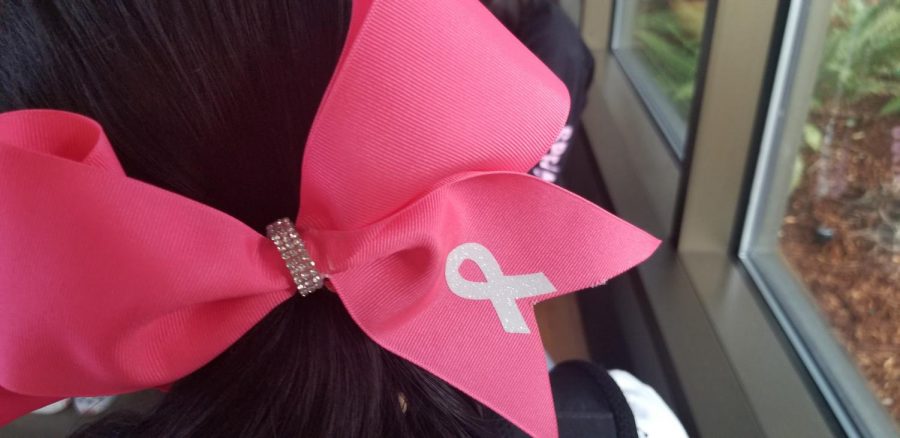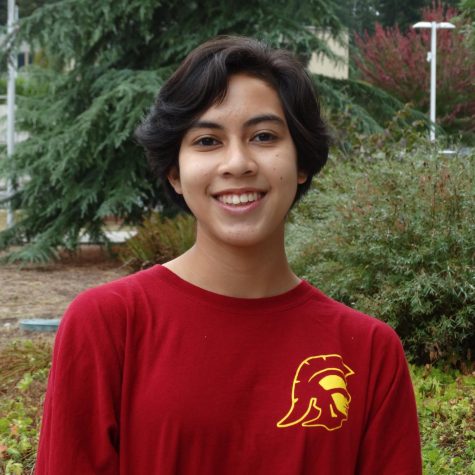October’s Pink Wave: Breast Cancer Awareness Month at IHS
SUPPORT WITH FLARE The IHS Cheer Team’s pink bows with the breast cancer pink ribbon stitched on the front are just one example of accessories fall sports teams use to promote Breast Cancer Awareness Month.
October 1, 2019
As October approaches, IHS is gearing up to “think pink” and promote the month-long campaign for breast cancer awareness with fundraisers and pink-tinted sporting events.
According to Britannica and Verywellhealth, Breast Cancer Awareness Month has been recognized by the world since its origin in October 1985 and every year, the month is used to, as senior Natalie Fortes said, “…raise awareness for the cancer itself, and to honor the people who have lost their lives to it and those who are currently fighting it.” The campaign also aims to educate people about methods of prevention and early detection and raise money to support research and survivors. The staple of Breast Cancer Awareness Month is its international color, pink, as well as the pink ribbon, a lasting symbol of Breast Cancer Awareness Month created by Evelyn Lauder and Alexandra Penny in 1992.
When Breast Cancer Awareness Month is mentioned, many share thoughts akin to those of junior Timmy Crandall, who said, “The first thing you think about is just the color pink.” On par with the campaign’s reputation, IHS is a flurry of pink during Breast Cancer Awareness Month with teachers, clubs, sports teams, ASB, and the student body hard at work to promote the annual campaign.
This year is no different; the familiar sight of teachers and students bathed in pink, sports teams repping extra with their purple and gold, and ASB fundraising for breast cancer education, research, and survivors is a certainty. This year, to earn donations, ASB will spend the month selling breast cancer awareness stickers and pins under the stairs at lunch. The American Cancer Society will receive all the profits. Sophomore Erin Tylutki, who is on the planning team for this project, expressed her commitment to the campaign and encouraged students to keep an eye out for the fundraiser. She said, “In ASB, our teacher is like, ‘Oh, I’m not big on Breast Cancer Awareness Month’ but she was diagnosed with breast cancer, so it’s kind of dear to our hearts. We want to do our best.”
Joining ASB’s campaign is the volleyball team. Although pink-outs are usually at football games, volleyball coach Tami Reese and junior Rachel Ratcliffe, a member of the team, said that this year, IHS’s “Dig Pink Night” will be at the girls’ volleyball game on Oct. 7. Both the student body and the players will be painted pink and the profits from tickets and concessions will join ASB’s funds for the American Cancer Society. Along with these events, members of fall sports teams like Fortes, sophomore Jacob Law, and senior Isaac Pak said that cheer and dance will be sure to rep their usual pink bows, poms, and uniforms while other fall sports teams like football, girls’ soccer, and boys’ tennis will be incorporating pink socks, bands, under armor, towels, and other accessories into their game-day swag.
Breast cancer is a tragically prevalent disease and the most common cancer affecting women. According to the American Cancer Society, in 2019, the projected number of new breast cancer cases is expected to be approximately 1,762,000 people.
A conversation with ASB coordinator Kelly Henry revealed the harrowing process of dealing with breast cancer from diagnosis to recovery. Describing the incident that prompted her to go to the doctor, she said, “It was terrifying. It was a Thursday when I found a lump in the shower that just felt weird, and I went into my doctor and she said, ‘Yeah, that is something, but you know what, I’m sure it’s a cyst. You’re very young, and there’s no history in your family.’” The following Tuesday, Henry explains, someone called, “[My obstetrician] told me, ‘You have breast cancer,’ and I was just sitting in my kitchen. I was standing and then I was sitting because it just blew me away. I was 32 and there was no history in my family. It was a complete shock.” If receiving the diagnosis was difficult, it was minuscule compared to the long road to recovery Henry described which included chemotherapy, a bilateral mastectomy, and proton radiation therapy. These treatments are drug-based, surgical-based, and radiation-based breast cancer treatments, respectively.
Almost more difficult than combating the disease physically seemed to be the mental stress associated with treatment and recovery. Crandall, whose mother went through treatment, said, “It’s crazy to see what people have to go through and how much you have to stay happy with your life and keep fighting through it. It’s a crazy process, and some people don’t beat it and some people do. My mom was fortunate enough to beat it.” Henry explained how hard it is to stay positive throughout treatment and said, “When days seem really sucky and I started to feel really horrible about, man, I have cancer. I always try to remember that it could’ve been so much worse. It could’ve metastasized further than my lymph nodes, it could’ve gone everywhere… Today I was crying in the car on my way to radiation, but I try to remember that it could be so much worse. There’s a little girl that gets radiation right before me, she’s in first grade, and I’m not her, I’m 32. And then, that’s not my daughter. It still sucks, but it could be worse, so I’m just really grateful for things.”
From avid breast cancer awareness campaigners to simple pink-swathed supporters of solidarity, ASB and the volleyball team invite all students to donate to their project and bring any blinding, hot pink article of clothing to their game. As October passes, remember through the flashy colors the purpose of Breast Cancer Awareness Month and the people behind the campaign for awareness.



